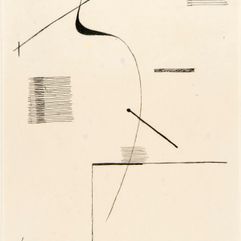

Burgoyne Diller
1906 - 1965
Burgoyne A. Diller was an American abstract painter. Many of his best-known works are characterized by orthogonal geometric forms that reflect his strong interest in the De Stijl movement and the work of Piet Mondrian in particular. Overall, his Geometric abstraction and non-objective style also owe much to his study with Hans Hofmann at the Art Students League of New York. He was a founding member of the American Abstract Artists. Diller's abstract work has sometimes been termed "constructivist". He also did figurative and representational works early in his career working as a muralist for the New York City Federal Arts Project.
Life
Diller was born in The Bronx, New York in 1906 to Andrew Diller, a violinist and conductor, and Mary Burgoyne. His father died in 1908, while Diller was just three years old. His mother would then marry an engineer named Adrian Adney. In 1919 he and his new family moved to Battle Creek, Michigan. When he was a child, he once had an illness that caused him to miss a year of school. During this period, he began to draw. This was his first exposure to the world of art and he exhibited a natural talent for it. Diller attended Battle Creek High School and Michigan State University. He graduated from Michigan State University in 1927 and moved to Buffalo, New York, where he lived with his maternal grandfather.
In Buffalo, Diller worked many odd jobs before landing a steady position as a janitor. At this time, he began to sell a few of his artworks and eventually this income allowed him to move to New York City where he began studying at the Art Students League in 1929. He enjoyed success and recognition at the League and was awarded a scholarship job at the school's bookstore. Diller ended up leaving the Art Students League in 1933 and took up a position with the Works Progress Administration (WPA). However, in 1941 Diller, along with other WPA supervisors, was suspended from the WPA due to an alleged Communist infiltration of the WPA. After an investigation, no evidence was found to incriminate Diller and he was soon reinstated. In 1943 Diller enlisted in the U.S. Navy and was assigned to the Training Aids Development Center. There he invented a hand-held Morse code training device that led to three million of the devices being created. He was awarded a patent for the invention in 1945. He was released from active duty after World War II in November 1945 as a lieutenant (junior grade) and remained in the naval reserve until 1954, retiring with the rank of lieutenant. During his time in active duty, he stopped creating art altogether. However, once the war ended, he took up art once again. In 1946 Diller was hired as an assistant professor at Brooklyn College and was soon promoted to a full-time position. He was granted tenure at the college in 1949. He remained on the faculty until his death in 1965.
In 1930 Diller married Sarah "Sally" Bernadette Conboy, who worked in the classified department of The New York Times. "Her steady income helped the couple maintain a modest lifestyle throughout the Depression." By the early 1950s, Diller began creating art at a very inconsistent rate due to "mounting personal problems, excessive alcohol consumption, and a sense of rejection by an art world dominated by Abstract Expressionists." In 1959, Diller's studio flooded and none of the artwork he had stored in his basement could be salvaged. Contributing to the problems in his life was Sally's own alcoholism which led to her death in 1954 of cirrhosis of the liver, just months after she had retired from The New York Times. They never had any children. That same summer, while visiting his mother and stepfather in Michigan, Diller met Grace Kelso LaCrone who had just separated from her husband. Once her divorce was finalized, she and Diller married in 1955. They too never had any children together. In his later years, Diller moved to Atlantic Highlands, New Jersey, where his home and studio were both near the shore. By 1965 Diller's health had seriously declined after years of smoking and alcohol abuse. He died that very year at the age of 59 due to complications of heart disease and pulmonary edema while at the French Hospital in Manhattan.
Text courtesy of Wikipedia, 2024








